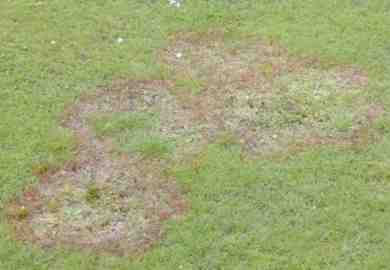Home / Information & advice / Lawn diseases / Bentgrass take-all patch
If you answer yes to the above questions, then your turf may have developed the disease take-all patch.

Take-all patch is caused by a fungus that lives in the soil, it does not attack the leaves. The fungus infects and kills the roots and stolons of bentgrass. As this happens, the leaves will display colour changes (red, yellow and brown) and this is what you will observe. Any disease that attacks the roots of your turf is serious. The fungus that causes take-all patch can be found in most soils in the U.K. However, only bentgrass is attacked by the take-all fungus.
If you have ryegrass, fescue or smoothstalk turf such as Rolawn Medallion it will not develop take-all patch. If your turf is a mixture of grass varieties including bentgrass, then your turf could be affected by take-all patch.
The fungus has been studied a great deal, but it is still difficult for experts to predict when or why the disease develops in a turf. The fungus is most destructive when the soil is moist, with temperatures between 12-18°C and a soil pH of 7 or above. Turf growing in sandy soil is more severely attacked than turf rooted in heavier soil. In addition, the disease is most severe in turf that appears to be growing well but has shallow roots. In general, the disease does not appear in turf for several years after it is laid. Once it appears, it is likely to reappear year after year for many years. Patches will increase by about 75mm in diameter per year. As the soil temperature increases above 18°C, the severity of the disease will naturally decrease, but this does not mean take-all patch is gone.
The healthier the bentgrass is, the less severe take-all patch will be. It may still develop, but your turf will recover much faster than weak turf, once the soil warms up. Healthy bentgrass has many white stolons with deep roots. Keep your fertility balanced and do not mow your turf too short. The shorter your turf is mown, the shorter the roots will be. If your roots are not deep, you might consider aeration to encourage deeper rooting. Finally, top dressing diseased turf with light applications of natural soil has been observed to reduce disease severity.
If your soil is pH 7 or above, you are more likely to have severe take-all patch. To reduce the pH of existing soil you can add elemental sulphur, but this can sometimes result in turf damage, and it can take years and repeated applications to achieve a substantial reduction in the pH. Another means to gradually lower the soil pH in the root zone is to use acidifying fertilisers. Until the soil pH is below 6, you are not going to realise a significant benefit. Whilst we recommend a soil pH of 6 to 6.5, your turf will still grow well at a soil pH below 6. At this level, or below it, will ensure that the take-all fungus is kept weak. If you are replacing turf that was killed by take-all patch, you need to do at least two soil preparations. The first is to check and adjust the soil pH. The second is to cultivate the top 150-300mm of the soil after the old turf is removed. Failure to do this will almost certainly result in the new turf becoming severely diseased.
There are fungicides available for the control of take-all patch, but remember, the use of fungicides should be integrated with the cultural practices described above. Never rely on fungicides alone. If a fungicide is required, it is critical that you apply it when the take-all fungus is starting to become active, in the spring of the year. You can determine this by measuring the soil temperature at 50mm deep at about midday. When the soil temperature is about 12°C, the fungus will start to attack the grass. That is when to treat the grass with the fungicide you select. Follow the manufacturer’s recommendations closely.
We recommend that you obtain advice about chemical and non-chemical grass treatment products directly from the manufacturer.
If your turf has developed severe take-all patch, it will require several months for the turf to re-grow sufficiently to heal itself. You can overseed the turf with ryegrass, fescue or smooth stalk, such as Rolawn Medallion Premium Lawn Seed. These grasses are not susceptible to the take-all fungus. Overseeding with bentgrass will only result in more disease, because the fungus attacks young bentgrass seedlings faster than older grass.
Take-all patch is very difficult to control, because it is a soil-borne disease and is more severe on turf that is receiving intense management. It is advisable to discuss turf which is affected by take-all with a turf expert. Visit the STRI website www.stri.co.uk.